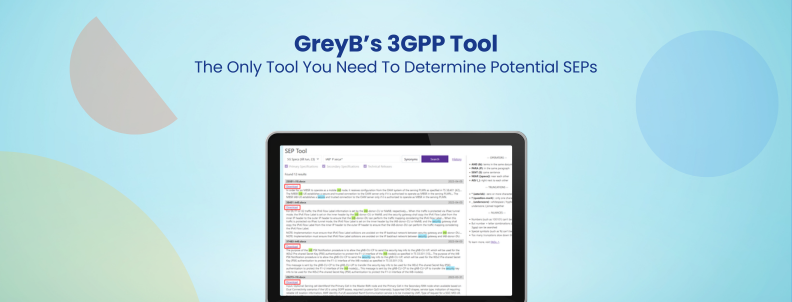Technical standards, evolving technologies, and scattered patent declarations complicate the process of determining standard essential patents (SEPs). This is further complicated by the need for manual searches across various databases, which are time-consuming and prone to errors and omissions.
However, what if there was a solution that could simplify this process?
GreyB’s 3GPP tool addresses these challenges by identifying potential SEPs while cutting through the clutter. This article discusses how the tool benefits in determining potential standard essential patents and provides an example to demonstrate how it can be applied in the real world.
How is GreyB’s 3GPP Research Tool Useful in SEP Identification?
- Centralized Repository of Standard-related documents: The tool eliminates the need for time-consuming searches across various sources. It provides a central location for up-to-date standards documents, streamlining access and expediting the SEP identification process.
- Targeted Efficiency with Keyword Search: Rather than sifting through vast databases document by document, the tool has keyword search functionalities. This targeted approach allows for simultaneously examining potential SEPs across various standards.
- Enhanced Accuracy: The 3GPP Research Tool uses search algorithms to improve accuracy and reduce the risk of missing critical patents during identification. This is particularly valuable considering the potential consequences of overlooking a crucial SEP.
- Direct Link to Download Standards: One standout feature of GreyB’s 3GPP Research Tool is providing a direct link to download the relevant standard associated with the identified patents. This eliminates the need for separate searches and grants users immediate access to the foundational documents necessary for in-depth patent analysis.
- Available for a Wide Range of Standards: GreyB’s 3GPP Research Tool is available for 3GPP Standards, WLAN standards, and WFA Specifications, providing comprehensive coverage for patents within these crucial domains.
- Searching concepts in the specifications: Beyond patent identification, the tool will search for specific concepts within the specifications. This functionality is useful for determining whether a particular concept has been implemented within the standards and, if so, pinpointing the exact time of its inclusion. This level of detail provides insights to understand the ever-evolving landscape of technical standards.
3GPP Research Tool in Action
Let’s walk through a real-world example of how GreyB’s 3GPP Research Tool can streamline SEP identification. We’ll consider a patent (EPXXXX672B1) and demonstrate how the tool assists in determining its SEP status.
Understanding the Patent Claim:
The first step involves a thorough understanding of the patent’s claim, specifically focusing on the claimed procedure and the key elements involved.
In this case, EPXXXX672B1 had the following claimed element
A method carried out by a …. Comprising:
sending …. connection request in …. to a network access node ….; and
receiving …. comprising a radio resource control, RRC, …. as a response to the connection request, an indication that the …. cannot be connected at the current time,
characterized by
the RRC connection …. comprising information that indicates that the …. should de-prioritize a current carrier frequency or current radio access technology.
Keyword Brainstorming and Search String Construction:
After a clear understanding of the claimed procedure, GreyB’s 3GPP Research Tool comes into the picture. This involves brainstorming relevant keywords that capture the essence of the claimed steps.
For example, keywords like “connection request,” “de-prioritize,” and “radio resource control” might be extracted from the claim. These keywords are combined using appropriate search logic within the tool to create a targeted search string.
Identifying Relevant Standards Text:
Once the search string is established, the tool searches the vast collection of 3GPP standards documents. It retrieves relevant text snippets from the specifications that potentially correspond to the claimed procedure.
Verification and SEP Determination:
The retrieved text snippets are then carefully examined to determine if they overlap with the claimed procedure in the patent. This in-depth analysis allows the analyst to make a final determination regarding the patent’s SEP status.
For the above case, relevant text was identified in 3GPP TS 38.331. Further analysis confirmed that the procedure laid down in this specification is similar to the procedure claimed in the subject patent.
The table below shows the patent claim’s overlap with 3GPP TS 38.331, identified using GreyB’s 3GPP Research Tool.
| Subject Patent – EPXXXX672B1 | 5G Specs – 3GPP TS 38.331 V17.4.0 (2023-03) |
| A method carried out by a …. comprising: sending …. connection request in …. to a network access node ….; and | This procedure resumes a suspended RRC connection, including resuming SRB(s), DRB(s), and multicast MRB(s) or performing an RNA update. It is also used to initiate SDT in RRC_INACTIVE. Analyst Comment:- The UE sends a connection request in uplink signaling by using the RRCResumeRequest message to the network access controlling the cell in which the UE is currently located. |
| receiving …. comprising a radio resource control, RRC, …. as a response to the connection request, an indication that the …. cannot be connected at the current time, | 5.3.8.2 InitiationThe network initiates the RRC connection release procedure to transit a UE in RRC_CONNECTED to RRC_IDLE or to transit a UE in RRC_CONNECTED to RRC_INACTIVE only if SRB2 and at least one DRB or multicast MRB or, for IAB, SRB2, is set up in RRC_CONNECTED; or to transit a UE in RRC_INACTIVE back to RRC_INACTIVE when the UE tries to resume (for resuming a suspended RRC connection or for initiating SDT); or to transit a UE in RRC_INACTIVE to RRC_IDLE when the UE tries to resume (for resuming of a suspended RRC connection or for initiating SDT). The procedure can also release and redirect a UE to another frequency. Analyst Comment:- The Network node was sending an RRCRelease message to the UE when the UE was trying to make a connection with the network node using the RRCResumeRequest message here; the RRCRelease is acting like a connection reject message when the UE tries to connect to the network node, but the node is rejecting the request. |
| characterized by the RRC connection …. comprising information that indicates that the …. should de-prioritize a current carrier frequency or current radio access technology. | The UE shall: …… 1> if deprioritisationReq is included and the UE supports RRC connection release with deprioritisation: 2> Start or restart timer T325 with the timer value set to the deprioritisationTimer signaled; 3> Store the deprioritisationReq until T325 expiry; …… deprioritisation Req:- Indicates whether the current frequency or RAT is to be de-prioritized. Analyst Comment: The RRCRelease message comprises a deprioritisationReq, which, by definition, indicates the frequency or RAT that is to be de-prioritized. Therefore, the rejection message is the RRCRelease message and the information in the message that indicates the de-prioritizing is deprioritisationReq. |
Conclusion:
While manual analysis is still necessary to ensure the validity of standard essential patents, an advanced tool like the 3GPP Research Tool will help direct the right efforts toward the right place, especially in the case of large patent portfolios.
To gain a deeper understanding of your portfolio’s SEPs, try the GreyB Research Tool today.
Authored by: Piyush Sharma and Rohit Sood, Infringement Team
Edited by: Annie Sharma










